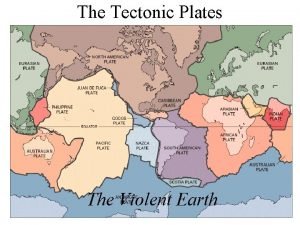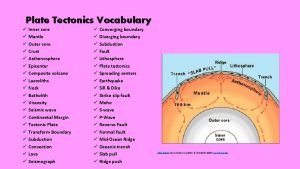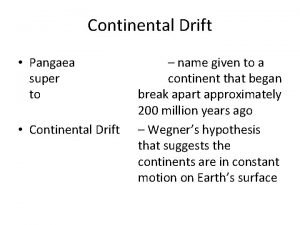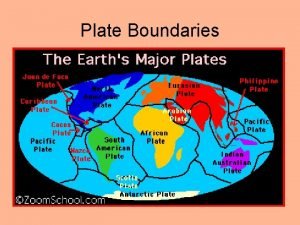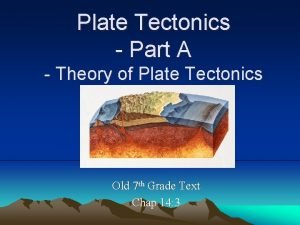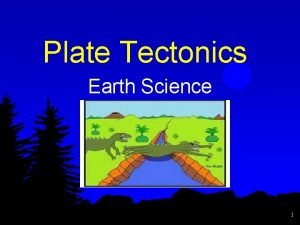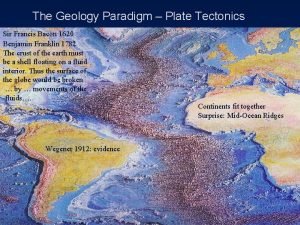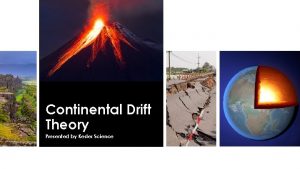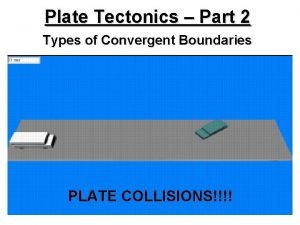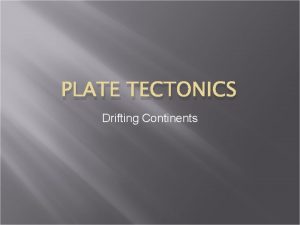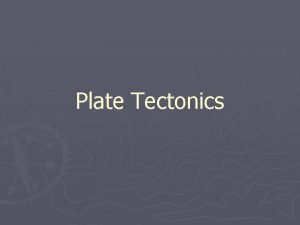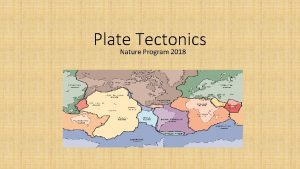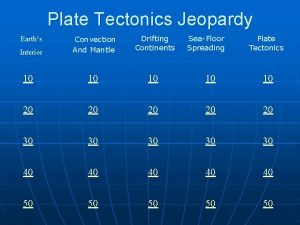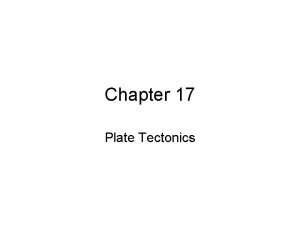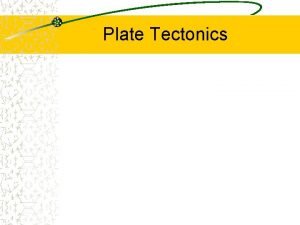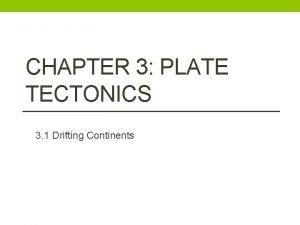PLATE TECTONICS Drifting Continents Drifting Continents Aside from













- Slides: 13

PLATE TECTONICS Drifting Continents

Drifting Continents Aside from earthquakes, volcanoes, and landslides, Earth’s surface appears relatively unchanged on a human time scale On geologic time scale, Earth’s surface is changing at huge rates South America is moving away from Africa 2 -3 cm/yr Volcanic islands that make up Hawaii moving NW at 8 -9 cm/yr

Early Observations of Moving Continents First people to consider moving landmasses were early mapmakers Explanations for continent moving included volcanoes, earthquakes, and floods 1912 Alfred Wegener proposed a hypothesis about continental movement

Continental Drift Wegener’s hypothesis was called continental drift Continental drift proposed that Earth’s continents had once been joined as a single landmass He called the supercontinent Pangaea, Greek word meaning “all the earth” Proposed Pangaea began to break apart about 200 million years ago Continents still moving slowly today


Evidence of Pangaea Wegener was first person to base his idea on more than just the puzzle-like fit between continents This was some of his evidence: (1) evidence from rock formations (2) Evidence from fossils (3)Ancient Climate Evidence

Evidence from Rock Formations When Pangaea began to break apart, large geologic structures like mountain ranges would fracture as continents separated Based on this, should have similar rock types on opposite sides of the Atlantic Ocean EX: rocks of Appalachian Mts share similar features with rocks in Greenland Europe-all of these rocks are older than 200 million years old See other matching rock types in book p. 445

Evidence from Fossils Similar fossils of different plants and animals that once lived on land were found on widely separated continents Land-dwelling animals like Kannemeyerid could not have swum great distances that now exist between continents


Used fossils from Glossopteris, a seed fern, to show that continents must have been connected and have same climate to support this plant life

Ancient Climate Evidence Studying sedimentary rocks, Wegener found evidence of vast climate change on past environments and climates EX: Coal forms from dead swamp plants. Coal deposits had been found in Antarctica, supporting the idea that Antarctica must have been closer to the equator at one time

Glacial Deposit Evidence EX: Glacial deposits (in Africa, India, Australia, and South America) nearly 300 million years old led Wegener to believe that these landmasses may have been joined and covered with ice

Rejected Hypothesis Even though Wegener had lots of evidence to support his theory of Pangaea, it was rejected due to two major flaws: (1) What was causing the continents to move? (2) How could continents move without shattering the ocean floor?
 San andreas fault map
San andreas fault map Harry hess and seafloor spreading
Harry hess and seafloor spreading Picture of alfred wegener
Picture of alfred wegener Inner core vocabulary
Inner core vocabulary A plate tectonics puzzle worksheet answer key
A plate tectonics puzzle worksheet answer key Plate tectonics vs continental drift
Plate tectonics vs continental drift Future plate tectonics
Future plate tectonics Driving force of plate tectonics
Driving force of plate tectonics Tectonic plates
Tectonic plates Francis bacon plate tectonics
Francis bacon plate tectonics Convergent boundary divergent boundary transform boundary
Convergent boundary divergent boundary transform boundary Plate tectonics test review answer key
Plate tectonics test review answer key Continental drift theory
Continental drift theory Boundaries of plate tectonics
Boundaries of plate tectonics
